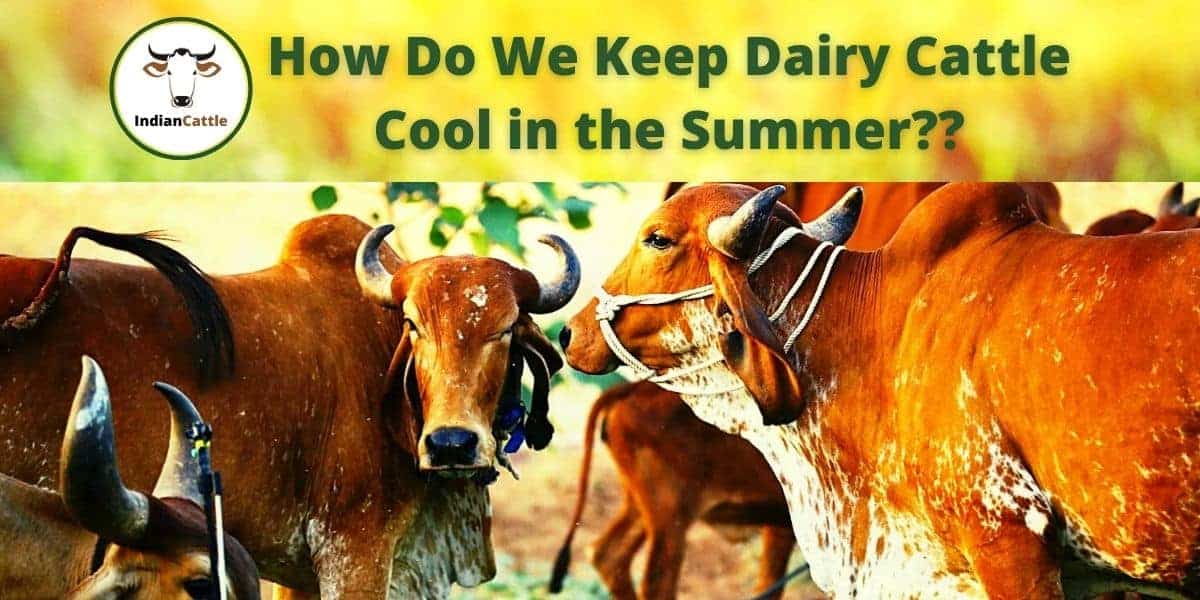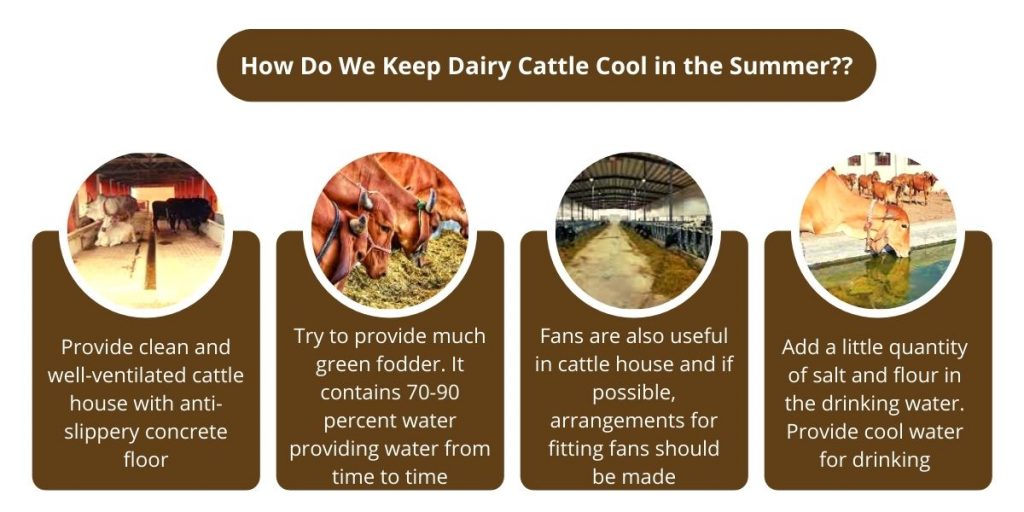
Animal Management in Summer
Animal management during summer requires special attention. Summers are hot and long in North-Western India. Here the atmospheric temperature rises to higher than 450 Celsius. Animals become stressed in this weather. Stress adversely affects the digestive system and milk production performance of animals. In this season, even a little inadvertence in care of newborn animals may permanently impair their future growth, disease resistance ability and production performance. Improper care in animal keeping during summer may cause 10 to 30 percent reduction in consumption of dry matter and up to 10 percent decrease in milk production ability of animals. Apart from this, oxidative stress caused by excess heat adverse effects on the ability of animals to fight against diseases and they become susceptible to different diseases occurring in the following rainy season. As such, the production and reproduction efficiencies of animals are reduced.
Summer Management of Dairy Cattle
In summer, the reproductive performance of bulls may also be affected adversely. The quantity and quality of semen produced by bull are poor and their libido is decreased. These effects are more prominent in buffaloes as their black skin-coat and lack of hair help the absorption of more heat. Moreover, buffaloes have fewer sweat glands than cows due to which they had difficulty in dissipating heat from the body. In hot environment, both period and intensity of estrus are considerably reduced in female animals and they may become anestrus. The following steps are therefore recommended to alleviate adverse effects of the summer season and to help to maintain the production and reproductive performances of animals.

- Provide clean and well-ventilated animal house with anti-slippery concrete floor having slope for drainage of urine and water. The roof of animal house should be insulator to avoid overheating during summer. Asbestos sheets can be used for this. On very hot days, 4-6 inches thick grass layer of thatch can be put on the roof. These layers act as heat insulators due to which the inside temperature of animal house remains low. White painting or fixing shining aluminum sheet on roof of animal houses are useful in reflecting sunlight. The minimum height of roof of animal house should necessarily be 10 feet for proper circulation of air and the animals are protected from heat of roof. Cover windows, doors and other open places of animal house with sacks and sprinkle water on these sacks. Fans are also useful in animal house and if possible, arrangements for fitting fans should be made.
The animal house should not be overcrowded. Each animal should get sufficient space as per its requirement. An adult cow and buffalo need 40 and 50 square feet area, respectively. In the open house system per animal requirement is 35 and 40 square meter open area and 7 and 8 square meter covered area for cow and buffaloes, respectively. Animals in the stage of advanced pregnancy and close to parturition should be provided 12 square meters covered and open areas each. It is necessary that breeding bulls are provided 12 square meters covered and 120 square meters open area, where they can have enough exercise to maintain their breeding potential
- Spray cold water three to four times on an animal body if the atmospheric temperature is high. If possible buffaloes can be taken to ponds or pools for bellowing. Experiments show that spraying cold water on animals at noon is useful in improving their production and breeding performances.
- Intake of fodder by animals is reduced during summer. When the environmental water temperature is higher than the body temperature, animals eat less dry fodder because much heat is generated from the body on the digestion of dry fodder. Therefore, animals should be provided fodder in the morning or evening only, and as far as possible try to provide much green fodder. This practice has two advantages, first animals relish green fodder and thus consume enough nutritious feed, and second green fodder contains 70-90 percent water providing water from time to time. In case animals are going for grazing, they should be taken to pasture only in the morning and evening. Farmers should sow Mung bean, maize, cowpea, etc in the month of March -April to ensure supply of green fodder during summer. Livestock owners without irrigated land can cut green grass in time and dry and store it. This grass is rich in protein, easy to digest, and nutritious.
- In summer, the appetite of animals decreases, and thirst increases. As such provision of sufficient drinking water should be made at least three times a day to animals. In addition, add a little quantity of salt and flour in the drinking water. Provide cool water for drinking. For this, arrange to keep the water tank in a shaded place. Water pipe should not be laid through open sun and attempts should be made for the underground pipeline to prevent the warming of water during day time. Earthen pitchers can be used for providing cool water for animals in summer.
- Shady trees are very much necessary nearby animal houses. This tress not only provides shade for animals but also protects them from hot summer winds.
Signs and prevention of heatstroke in summer
Though the ill effects of the summer season are seen in all species of animals, cows, buffaloes and poultry are more affected. It is due to black color, less number of sweat glands and effects of special hormonal in buffaloes, and absence of sweat glands and higher body temperature (107 0F) in poultry.
- Animal show loss of appetite
- Loss of milk production in lactating animals
- Epistaxis and diarrhea
- Nose and eyes are red and heartbeats are rapid
- Animal shows deep breathing and panting, protrusion of tongue, and feeble breathing at the terminal stage
- Excessive salivation and frothing at the mouth
- Animal show uneasiness and tries to find shade and doesn’t like to sit
- Weak and dull reproductive activities- During the summer season, the reproductive efficiency of buffaloes and cross-bred cows become dull and their estrus cycle is prolonged and fiery. As such the chances of pregnancy are declined considerably
- Fat and protein contents decrease in cow and buffalo milk affecting its quality
- Embryonic mortality increases in female animals
- Animals show abnormal behavior
- Breeding potential of male animals decreases
- Sperm mortality in semen increases
- Age of puberty increases in male and female
- Neonatal mortality rate increases
- The animal may die for want of proper care and treatment
Preventing Heat Stroke
Some precautions should be taken to protect animals from heatstroke. Following guidelines and preventive measures are useful for the proper care of lactating animals and newborns to protect them from heat stroke and other diseases as well as to improve milk production.
- Animal house should be constructed in a manner to provide proper space to animals to ensure free movement of air.
- Khas (vetiver) or Jute sacks curtains should be placed at the main entrance of the animal house to protect animals from direct sun.
- Fans, coolers, and sprinkler systems can be fitted in animal house to protect animals from heat. Fans and coolers can reduce the temperature by 100 Size of fans for inside animal house use is 36-48 inches and should be fitted on the wall about 5 feet height from the ground at 300 angles. A cooler is sufficient enough to keep the 20 square feet area very cool.
- Shady trees around open area of the animal house helpful in lowering the temperature
- Adequate clean drinking water should always be available. Keep the drinking water in shade.
- If possible provide cool drinking water to animals after milking.
- Provide cool water 3-4 times in summer. To avoid inconvenience, arrange drinking water at least in two places in animal houses with a large number of animals. Generally, an animal needs 3-5 liter drinking water per hour. Always keep water and water troughs clean. The temperature of the water should be 70-80 0F, which is liked very much by animals
- Buffaloes should be bathed at least 3-4 times daily and cows twice a day
- Troughs should be cleaned regularly with lime. Don’t give kitchen waste food to animals.
- Don’t feed carbohydrate-rich food such as flour, bread, rice, etc to animals. Keep grain and fodder ratio 40:60 for a balanced diet.
- Sorghum grown during summer may contain toxic material, which can be harmful for animals. Therefore, in the absence of rain, irrigate the sorghum crop 2-3 times before feeding it to animals.
- Animal fodder must contain 18-19 percent soluble fiber. Also, animal diet can be supplemented with yeast (which helps in the digestion of fiber), and fungal culture (e.g. Aspergilus oryzae) and niacin, which enhance energy (You may also like to read: Fodder Bank for Livestock Rearers).
- Since the consumption of grain is reduced, animals can be fed with fat rich feed such as mustard cake, cotton seed, soybean cake or oil or ghee as well. Dry matter in the animal feed contains up to 3% Besides this, 3-4 percent fat should be fed additionally. The total concentration of fat should not be more than 7-8 percent.
- In summer lactating animals should be fed up to 18% Excess quantity of protein fed to animals is excreted in urine and sweat. Give stone to supplement calcium in the diet for maintaining milk production.
- Animals should be vaccinated for HS, FMD, BQ, etc. in summer to prevent the occurrence of these disease in the rainy season
- Consult veterinarian in case of heatstroke in animals.
Read More: Heat Stress During Summer Reduces Milk Production in Livestock
Assistant Professor, Department of Veterinary Medicine
DUVASU, Mathura- UP
